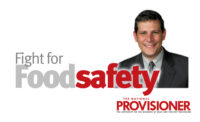Providing another barrier for pathogens
Post-harvest pasteurization methods protect against foodborne pathogens, while keeping labels clean.

Processors use post-harvest pasteurization methods to put another barrier between their product and Listeria — their clean, sustainable qualities are an added benefit.
It seems even post-harvest pasteurization methods, such as high-pressure pasteurization and thermal pasteurization, are promoting their sustainable qualities today.
“High-pressure pasteurization [HPP] and thermal pasteurization are seeing more applications today,” says James S. Dickson, Ph.D., professor, Department of Animal Science, Iowa State University, Ames, Iowa. “The industry likes that HPP is clean and doesn’t go on labels. The big issue [for acceptance] is still cost.”
Certainly, the meat industry, as well as many other sectors of the food industry, is continuing to adapt a stronger knowledge and dedication to process efficiency and sustainability.
“In some cases, this may mean updating current thinking on the use of current antimicrobial interventions in order to achieve goals such as reducing water consumption,” says Matthew Taylor, Ph.D., associate professor of meat science, Texas A&M, College Station, Texas. “This could mean re-assessing sanitation systems and SSOPs [Sanitation Standard Operating Procedures] to reduce water consumption. Nevertheless, any change in water use should not come at the expense of food safety respect to the process environment sanitation and the decontamination of products from cross-contaminating microbes.”
HPP vs. thermal pasteurization
HPP technology is recognized by both the USDA and FDA as a highly effective tool — although not the only one — in achieving required food safety criteria in many different product categories.
HPP is a cold pasteurization technique that puts sealed products into a vessel that subjects them to a high level of isostatic pressure, which is transmitted by water, to kill foodborne pathogens such as E. coli, Listeria and Salmonella and spoilage organisms and extend shelf life — without changing the nature of the product.
“This technology allows processors to produce what retailers and consumers are looking for: all-natural, preservative-free products with extended shelf life,” says Joe Ragozzino, vice president of operations, Stay Fresh Foods, Meriden, Conn., and Pennsauken, N.J. Demand continues to grow, he adds, and it has fueled innovation in the form of high-capacity, large-diameter HPP systems. The benefits of HPP have been noticed by many processors as well.
“Not using heat preserves product integrity,” says Ragozzino. “Flavor and texture are typically unaffected, yet the elimination of harmful pathogens is achieved. HPP protects the brand and provides insurance against every food processor’s worst nightmare: product recall.”
He notes that HPP can also aid in new product development, as well. “We’ve watched several of our customers who are making innovative new products double or even triple their output,” Ragozzino says.
Traditionally, HPP is more prevalent among further-processed, premium products, but more companies are embracing it as the cost goes down, Dickson says.
“It’s fairly predictable in that premium products used it in the past, because processors could justify the technology’s added cost,” he says.
Thermal processing, on the other hand, works by using heat to kill microorganisms in the foods without altering the characteristics of the product.
“Both HPP and thermal pasteurization work in that they provide an extra barrier against Listeria, for example,” says Dickson. “It comes down to the quality of the finished product,” as both methods cause some color changes.
The challenge with any of these technologies is on the engineering side, Dickson says.
“Part of HPP’s cost is maintenance and operations — some elements could be more efficient to bring the cost down,” he says. According to Ragozzino, integration could use some improvement.
“Many processors access HPP through a tolling company in order to benefit from the technology without a long-term financial investment,” he says. “Finding a nearby tolling center capable of flawless integration is essential.”
Tollers provide assistance on product testing, packaging selection, shelf-life studies and formulation changes. They also offer longer-term product storage, supplies inventory and order fulfillment.
The next phase of interventions
The next phase of post-harvest prevention methods may focus on developing and validating new technologies that prevent pathogen transmission from the pre-harvest environment to post-harvest meat, such as the use of non-pathogenic bacteria to reduce pathogen shedding in beef cattle, or technologies that reduce Salmonella carriage in lymph nodes at slaughter, etc.
“Processors/packers are excited about the development and availability of new technologies and interventions when they can be adapted into their current process line,” Taylor says. “Of course, new technologies that are developed and brought to market should provide a level of food safety at least as good, or greater than, interventions that are currently in use by industry members.”
Research also details the utility of some newly developed antimicrobial compounds on beef and red meat.
“New interventions that may control pathogens effectively but result in lowered product quality/shelf-life will have to be judged by the company that’s contemplating their use against their current product shelf-life, costs of use vs. expected benefit of use and costs of implementation to determine their utility to the processor,” Taylor says. NP
Looking for a reprint of this article?
From high-res PDFs to custom plaques, order your copy today!









